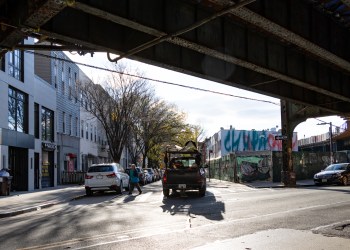The Verrazzano-Narrows Bridge Turns 60
Once the longest suspension bridge in the world, the bridge handles over 200,000 vehicles every day and plays a crucial role in connecting Brooklyn and Staten Island.

The Verrazzano-Narrows Bridge photographed in 1991 for a Historic American Engineering Record (HAER) study. Photo by Jet Lowe via Library of Congress
By Jada Camille, Brooklyn Paper
The Verrazzano-Narrows Bridge reached its 60th anniversary on November 21, and the monumental feat of engineering remains an integral piece of New York City’s infrastructure.
Once the longest suspension bridge in the world, and now the 13th-longest globally, the bridge handles over 200,000 vehicles every day and plays a crucial role in connecting Brooklyn and Staten Island.
To better understand the iconic structure, Brooklyn Paper spoke with experts from WSP, the firm behind the bridge’s original design and ongoing maintenance and preservation.

“This bridge is not merely a crossing; it’s a major lifeline that holds up 1.4 million tons of concrete and 143,000 miles of cable wire,” said Jonathan Morey, senior bridge engineer at WSP. “It truly represents the ingenuity of its time and the continuous advancements in engineering that keep it operational today.”
The bridge was initially proposed to connect Staten Island with the rest of the boroughs.
According to Stuart Rankin, a professional engineer and senior vice president of the National Bridges and Structures Practice at WSP, Staten Island was effectively cut off from the rest of the city before the bridge’s opening in 1964.
“You can’t even imagine the inconvenience it caused,” Rankin said. “The only way to traverse to Manhattan was by ferry, which limited both mobility and economic growth for Staten Island.”
The connection was first proposed as a tunnel with a rail connection to the other boroughs. However, shortly after construction began, the then government prohibited rail travel through the tunnel. This cut off any potential funding from the freight rails, effectively cutting the tunnel construction budget.
Now preparing to build a bridge, the engineers realized they were addressing more than just a transportation hurdle, but also the socio-economic effects the bridge would have. The ability to easily access other boroughs transformed Staten Island from an isolated locale into a thriving hub for residents and businesses.

“The construction of the bridge really gave Staten Island the opportunity to become a residential arm of New York City, showing the significant impact it has had on the economic development of the area,” Rankin said.
The bridge, named after European explorer Giovanni da Verrazzano, opened in 1964 with just the upper deck. Within a few years, congestion became a pressing concern. Six years later, in 1969, the lower deck opened to traffic.
“The bridge’s design anticipated this growth, and as engineers, we’re proud that we could pave the way for such rapid evolution,” Morey said.
Today, the bridge has 13 lanes, seven on the upper deck and six on the lower, and has become known for more than just carrying cars. It serves as the iconic starting point for the New York City Marathon, which saw more than 50,000 runners this year, and marks the end of the Five Boro Bike Tour. Most years, endangered peregrine falcons nest atop the structure.
And the bridge continues to evolve.
WSP constantly evaluates ways to maintain the structure, factoring in elements of climate change and car developments. Ongoing upkeep includes physical repairs, corrosion cleaning, repainting, and engineering studies. The team also stays abreast of new technological advancements to see how to better support the Verrazzano- Narrows Bridge.
Most recently, they implemented cable dehumidification to preserve the suspension cables.
“This bridge has to last through all kinds of conditions — Mother Nature, corrosion and urban stressors,” Morey said. “By injecting dry air into the cables, we can significantly reduce the moisture that leads to corrosion.”

Such methods are vital for ensuring the bridge remains safe and functional for generations.
The engineers at WSP said they learned unique lessons learned from working on the Verrazzano.
“Everything is massive,” Rankin said. “But that also signifies the resolve of those engineers back in the day, who built the world’s largest suspension bridge using relatively rudimentary tools and equipment.”
On the future of the Verrazzano-Narrows Bridge, Rankin posed a critical question.
“Can we picture a future where the Verrazzano-Narrows Bridge is no longer needed?” he said. “Given what it means to the communities, it’s hard to envision that day.”
As the anniversary approached, WSP opened its vault of historic photographs documenting the bridge’s construction and evolution over the past 60 years.
“We’re excited to share this curated selection with the public,” Morey said. “It’s essential to recognize not just the bridge’s significance but also its rich history.”
The Verrazzano-Narrows Bridge is a beacon of ingenuity and perseverance in a city that thrives on progress and connectivity, he said. It holds a particular symbolism for Morey.
“Don’t give up and keep trying,” he said.
Editor’s note: A version of this story originally ran in Brooklyn Paper. Click here to see the original story.
Related Stories
- As the Verazzano-Narrows Bridge Turns 53, See It Under Construction in Vintage Photos
- The Story of Brooklyn’s Grand Stage, the Brooklyn Heights Promenade
- How Master Builder Robert Moses Transformed Brooklyn as We Know It
Email tips@brownstoner.com with further comments, questions or tips. Follow Brownstoner on X and Instagram, and like us on Facebook.









I remember our family going to Fort Hamilton on the weekends to watch the construction of the Verrazano. We would have Sunday dinner at the original Hamilton House, then sit on a blanket by the cannons at the John Paul Jones Cannonball Park and be amazed at this wonder of construction